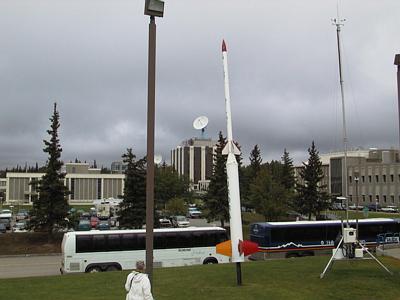27 July, 1999
July 27
For the past couple of days I have been shown the arctic research hotspots
in and around Fairbanks by Renee Crain of ARCUS. It has been a highly
educational tour. We began with a tour of the University of Alaska at
Fairbanks Museum. It presented the natural and cultural history of Alaska.
We also attended a presentation on the Aurora Borealis, also known as the
northern lights. One of the hallmarks of the Geophysical Institute at the
University of Alaska at Fairbanks is the auroral research program. The
Aurora Borealis occurs when the solar winds (referred to by some as cosmic
radiation, and by others as streams of subatomic parcticles originating from
the sun) flow into the earth's atmosphere. The parcticles are directed to
the polar regions by the earth's magnetic field. When the solar wind
enters the earth's atmosphere it interacts with the elements of the
atmosphere, creating a spectacular display of colors. Fairbanks is ideally
situated to observe this phenomenon. Millions of volts of electricity are
pumped into the earth's atmosphere via the northern lights each night. The
University at Fairbanks has their own rocket launching range from which to
launch measurement instruments high into the atmosphere to study the Aurora
Borealis.
We also visited the ASF located at the Geophysical Institute. ASF is an
acronym for Alaska SAR Facility. SAR is an acronym for synchronized
aperture radar. It is a remote sensing technique in which satellites use
radar to scan images of the earth's surface. ASF is one of a few
facilities which is capable of directing one of the orbiting satellites to
transmit SAR images to its computers. These images are used by researchers
to better understand surface topographic features on the earth's surface.
The Geophysical Institute has a large satellite dish on its roof to
communicate with the satellite.
We also met University of Alaska at Fairbanks glaciologist Carl Benson and
spoke with him about his work on an outburst lake in south-central Alaska.
We also toured the Alaska Volcano Observatory (AVO), which is also located
at the Geophysical Institute (a large facility located at the university).
AVO is in existence primarily to monitor the active volcanoes along the
Aleutian Islands. Numerous commercial airline flights make their course
over the Aleutian Islands. A volcano erupts along the Aleutian Islands on
the average of once a year. If an airplane were to fly into an ash cloud
from a volcanic eruption, a crash would be likely.
We also made a trip to the Large Animal Research Station, located near the
University. Research on the ecology and behavior of musk ox, reindeer, and
caribou is carried out at this facility.
It was a great trip to Fairbanks. It was impressive to see the degree of
interesting and significant research occurring in this seemingly out of the
way place. It was both inspirational and educational.

The view of the Geophysical Institute at the University of Alaska at Fairbanks. The rocket in the foreground is an example of what lifts research instruments into the upper atmosphere to study the Aurora Borealis, also known as the northern lights. One of the hallmarks of the geophysical institute is their auroral research. The satellite dish sits atop the institute. It is used to capture SAR images from passing satellites. SAR is an acronym for synchronized aperture radar, a technique which utilizes radar signals to take "pictures" of the earth's surface.
Contact the TEA in the field at
.
If you cannot connect through your browser, copy the
TEA's e-mail address in the "To:" line of
your favorite e-mail package.
|
